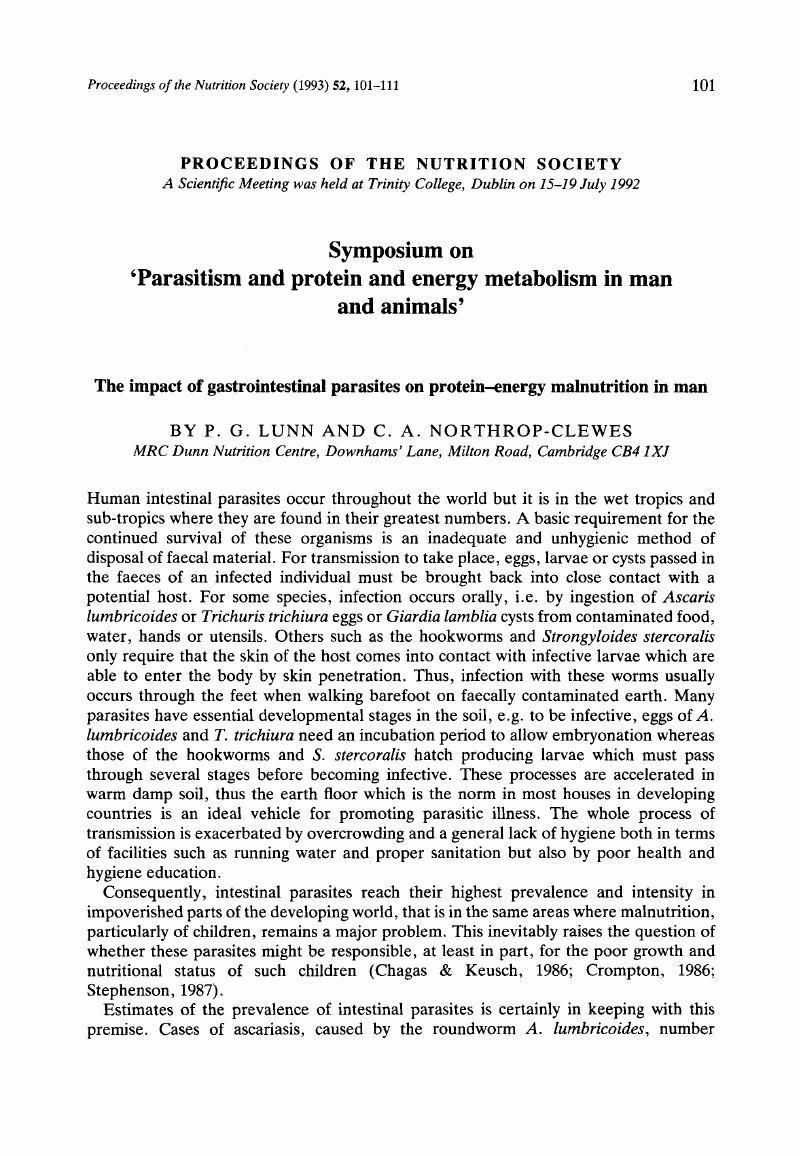Crossref Citations
This article has been cited by the following publications. This list is generated based on data provided by Crossref.
Rousham, E.K.
1994.
Perceptions and treatment of intestinal worms in rural Bangladesh: Local differences in knowledge and behaviour.
Social Science & Medicine,
Vol. 39,
Issue. 8,
p.
1063.
Simeon, D.
Callender, J.
Wong, M.
Grantham‐McGregor, S.
and
Ramdath, DD
1994.
School performance, nutritional status and trichuriasis in Jamaican schoolchildren.
Acta Paediatrica,
Vol. 83,
Issue. 11,
p.
1188.
Suttle, Neville F.
1994.
Seasonal infections and nutritional status.
Proceedings of the Nutrition Society,
Vol. 53,
Issue. 3,
p.
545.
Kruger, Marita
Badenhorst, Chad J.
Mansvelt, Erna P. G.
Laubscher, Jacoba A.
and
Benadé, A. J. Spinnler
1996.
Effects of Iron Fortification in a School Feeding Scheme and Anthelmintic Therapy on the Iron Status and Growth of Six- to Eight-Year-Old Schoolchildren.
Food and Nutrition Bulletin,
Vol. 17,
Issue. 1,
p.
1.
Updike, Phyllis
1997.
Impacting Maternal and Child Nutrition in Rural Vietnam: Experiences of an American Nurse–Consultant.
Journal of the American Academy of Nurse Practitioners,
Vol. 9,
Issue. 3,
p.
111.
Saldiva
Silveira
Philippi
Torres
Mangini
De Souza Dias
Da Silva
Buratini
and
Massad
1999.
Ascaris–Trichuris association and malnutrition in Brazilian children.
Paediatric and Perinatal Epidemiology,
Vol. 13,
Issue. 1,
p.
89.
Northrop-Clewes, Christine A
Rousham, Emily K
Mascie-Taylor, CG Nicholas
and
Lunn, Peter G
2001.
Anthelmintic treatment of rural Bangladeshi children: effect on host physiology, growth, and biochemical status.
The American Journal of Clinical Nutrition,
Vol. 73,
Issue. 1,
p.
53.
Koski, Kristine G
and
Scott, Marilyn E
2001.
GASTROINTESTINALNEMATODES, NUTRITION ANDIMMUNITY: Breaking the Negative Spiral.
Annual Review of Nutrition,
Vol. 21,
Issue. 1,
p.
297.
Saldiva, S. R. M.
Carvalho, H. B.
Castilho, V. P.
Struchiner, C. J.
and
Massad, E.
2002.
Malnutrition and susceptibility to enteroparasites: reinfection rates after mass chemotherapy.
Paediatric and Perinatal Epidemiology,
Vol. 16,
Issue. 2,
p.
166.
Lunn, P.G.
2005.
Encyclopedia of Human Nutrition.
p.
472.
Ehrenberg, John P
and
Ault, Steven K
2005.
Neglected diseases of neglected populations: Thinking to reshape the determinants of health in Latin America and the Caribbean.
BMC Public Health,
Vol. 5,
Issue. 1,
Parajuli, Rajendra Prasad
Umezaki, Masahiro
and
Watanabe, Chiho
2009.
Behavioral and nutritional factors and geohelminth infection among two ethnic groups in the Terai region, Nepal.
American Journal of Human Biology,
Vol. 21,
Issue. 1,
p.
98.
KEISER, JENNIFER
INGRAM, KATRIN
and
UTZINGER, JÜRG
2011.
Antiparasitic drugs for paediatrics: systematic review, formulations, pharmacokinetics, safety, efficacy and implications for control.
Parasitology,
Vol. 138,
Issue. 12,
p.
1620.
Lunn, P.G.
2013.
Encyclopedia of Human Nutrition.
p.
6.
Pacanaro, Carina P.
Dias, Sílvia R.
Serafim, Luciana R.
Costa, Mariana P.
Aguilar, Edenil
Paes, Paulo R.
Alvarez-Leite, Jacqueline I.
Rabelo, Élida M.
and
Hotez, Peter J.
2014.
Evaluation of Biochemical, Hematological and Parasitological Parameters of Protein-Deficient Hamsters Infected with Ancylostoma ceylanicum.
PLoS Neglected Tropical Diseases,
Vol. 8,
Issue. 9,
p.
e3184.
Crane, Rosie J.
Jones, Kelsey D. J.
and
Berkley, James A.
2015.
Environmental Enteric Dysfunction: An Overview.
Food and Nutrition Bulletin,
Vol. 36,
Issue. 1_suppl1,
p.
S76.
AYAN, Adnan
and
ERDOĞAN, Songül
2019.
Can Antiparasitic Cure with Clinoptilolite be Achieved in Dogs Naturally Infected with Giardia Duodenalis?.
Kocatepe Veterinary Journal,
p.
1.
CAMKERTEN, Güzin
ERDOĞAN, Hasan
URAL, Deniz Alıç
CAMKERTEN, İlker
ERDOĞAN, Songül
and
URAL, Kerem
2019.
Levels of Serum 25 (OH) D3 in Naturally Infected Lambs With Giardia duodenalis.
Kocatepe Veterinary Journal,
p.
1.
Kurniawan, Farid
Tahapary, Dicky L.
de Ruiter, Karin
Yunir, Em
Biermasz, Nienke R.
Smit, Johannes W. A.
Supali, Taniawati
Sartono, Erliyani
Yazdanbakhsh, Maria
and
Soewondo, Pradana
2020.
Effect of anthelmintic treatment on serum free IGF-1 and IGFBP-3: a cluster-randomized-controlled trial in Indonesia.
Scientific Reports,
Vol. 10,
Issue. 1,
Forti, Lucas Rodriguez
Szabo, Judit K.
and
Japyassú, Hilton F.
2023.
Host manipulation by parasites through the lens of Niche Construction Theory.
Behavioural Processes,
Vol. 210,
Issue. ,
p.
104907.



